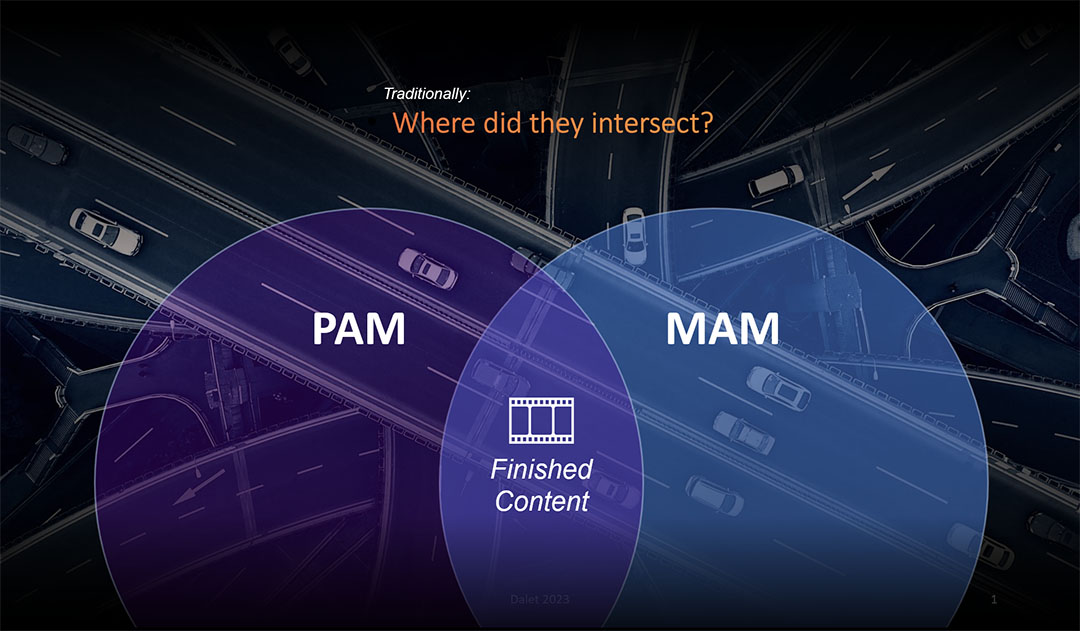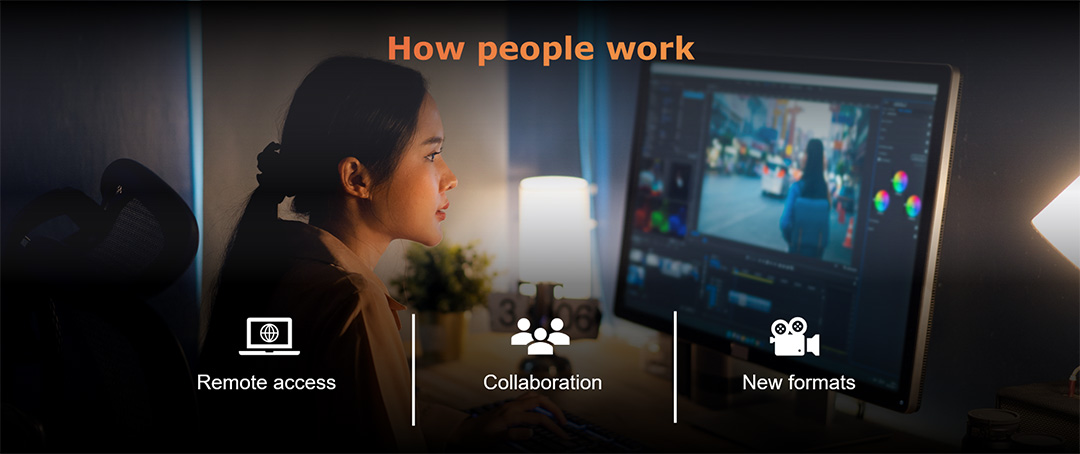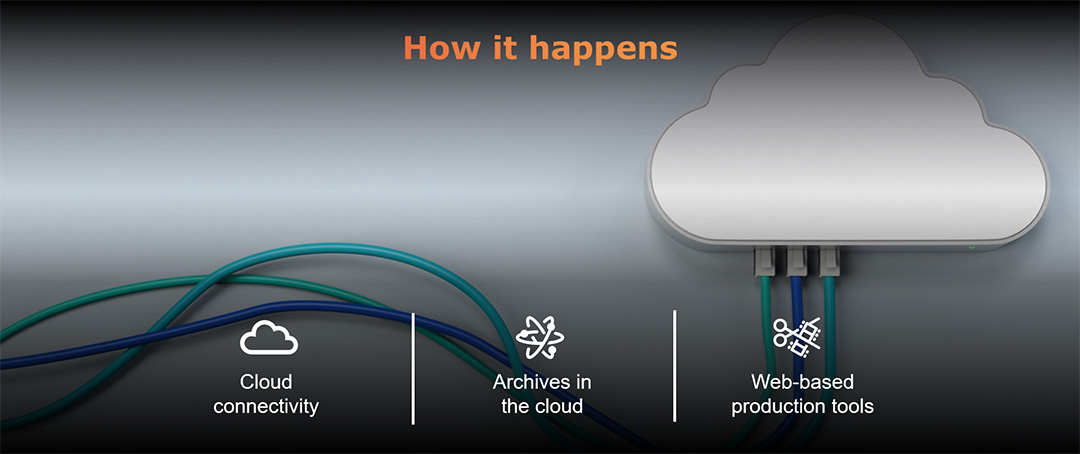Recently, the lines between Media Asset Management (MAM) and Production Asset Management (PAM) have become increasingly blurred.
This convergence reflects the quickly evolving needs of the industry. In recent years a huge leap forward in technological capability has coincided with rising creative demands and shifting media consumption trends. This has all had a significant effect on how media businesses operate.
As a direct result, MAM systems are evolving to provide greater production functionality to users.
So, what is the nature of this change? What brought it on? And why is it that cloud-native MAMs have started to take on PAM features?
Asset Management: As It Was

Historically, PAM and MAM served distinct functions.
PAM was all about managing the media production process within a localized, on-premise environment. It facilitated collaborative work but limited it to a single location, where all media assets were stored on a central server, accessible only to those within the four walls of the business.
Conversely, MAM offered a centralized repository for all digital media files, offering easy access to finished content for users across an organization. It connected active workspaces with archives. Historically, this too took place mostly on premises.
Typically then, the intersection point between PAM and MAM was only once a project was complete.
However, several factors have prompted these systems to adopt features from each other. This has led to a convergence of PAM and MAM.
How the Evolution of Media and Production Has Prompted Change
Three recent media industry changes have accelerated demand for MAMs with greater production capabilities. This can be summarized as how people work, how people watch, and how it all happens.
- How People Work: Creative Needs and Remote Access
The COVID-19 pandemic ushered in an exponential increase in the need for remote access, pushing the industry towards flexible work arrangements. A massive 92% of broadcasters now operate hybrid or fully remote working practices. Editorial and production teams need to collaborate effectively despite being geographically dispersed. This shift has necessitated access to media assets from anywhere, catering to new formats that demand higher bitrates and depth, adding to the complexity and volume of data managed remotely.

- How People Watch: Consumption Trends
The way people consume media has changed too. 99% of US households now subscribe to at least one streaming service. There’s an increased demand for content, leading to higher volumes of media consumption and production. However, this surge doesn’t correspond with increased budgets for production companies. To maximize the investment in production assets, there’s a growing need to tap into archives to repurpose content. What’s more, global streaming platforms have opened up local markets to wider distribution deals. Creating new language versions of existing productions is a more common requirement. Content is less likely to ever be considered “finished” as a result.

- How it Happens: Technology and Cloud Connectivity
The rise of cloud connectivity has been a key driver in blurring the lines between PAM and MAM. The adoption of cloud-native solutions allows for the storage and management of vast amounts of data more efficiently. Whilst a promise of the transformative effect of the cloud has been foreshadowed for decades, the technology is actually in use now. Cloud storage is being deployed to house petabytes of archives. This is a key driver in the blurring of MAM and PAM.
It should be noted that all three trends have been accelerated and exacerbated by recent economic changes. Higher inflation, market volatility, and general uncertainty brought about by major geopolitical events have led to a tightening of budgets across the board. Media companies are being forced to do more with less. Content repurposing and the development of additional monetization opportunities have become far greater necessities.

Convergence to Production-connected MAM
Today, what is being asked of PAM and MAM systems has almost become indistinct.
User requirements for both system types are converging. In response, we’ve developed a single, comprehensive asset management solution.
At Dalet, we refer to this as production-connected MAM. At its core, a production-connected MAM is a solution that manages content across the media supply chain, from acquisition to distribution.
This unified approach provides a central repository for all media assets, integrating production tools with archive environments. This facilitates the creation of content more efficiently, with accessibility from anywhere.
What this integration looks like:
- Production-Centric Media Library: A unified view into raw and finished media, enabling the connection and tracking of all content under one roof. This overlapping of previously distinct worlds significantly enhances productivity and insights.
- Insights and Efficiency: To avoid duplication and maximize existing content utilization, it’s now easier to identify which raw clips were used and in what context for any finished clip.
- Cost and Storage Monitoring: Cloud-native solutions offer lower total cost of ownership but require monitoring to prevent unexpected expenses. Modern MAM systems should provide detailed breakdowns of individual production costs, improving efficiency and decision-making as content demand grows.
- Comprehensive Ingest and Organization: Production-connected systems are format-agnostic, supporting a wide range of media types and facilitating automated workflows through proxy file creation, live ingest capabilities, and advanced media processing.
- Workflow Automation and Flexibility: The integration of MAM with Non-Linear Editing (NLE) systems and the implementation of workflow automation are core to the production-connected MAM concept. This not only simplifies the production process but also ensures greater mobility and efficiency, enabling rapid editing and rendering for multi-platform distribution.
A Use Case for Better Connecting MAM and PAM
One vertical where seamless, efficient workflow is increasingly important is sports broadcasting, where archival content plays a huge role in live transmission.
Fox Sports Australia recently approached us because its content wasn’t findable, it had disorganized metadata and its archives were not easily accessible.
Through the implementation of Dalet Flex, our production-connected MAM, we were able to build a centralized modern media library to provide ubiquitous access to content. We transported over 13,000 hours of live broadcast video to the cloud, where it became accessible to multiple teams across multiple sites. This provided the network’s production staff with powerful search tools that eased their content production pain points.
Ready to Streamline Your End-to-End Workflows?
The convergence of PAM and MAM represents a significant evolution for media organizations. At Dalet, we are leading the charge with Dalet Flex, our cloud-native, Production Media Asset Management solution.
Allowing our customers to make informed decisions and optimize their operations in an ever-changing media landscape is central to our thinking. By connecting not only to Dalet applications, but also to third-party systems through our robust API network, Flex sits at the core of any media operation.
This holistic approach not only streamlines the production process but also ensures that content creators can meet the growing demand for high-quality media with greater efficiency. To find out how Flex can integrate with your business, get in touch.
Get expert guidance
Book a free consultation now
Featured in: Archives | cloud media workflows | cloud storage | Cloud vs On-Premises | cloud-based mam | Dalet Flex | mam system | Media Asset Management | Media Supply Chain | Production Asset Management | Production-Connected Media Asset Management |
Aaron is the product marketing lead for Dalet, a leading technology and service provider for media-rich organizations. Aaron is spearheading go-to-market initiatives around cloud-native media supply chain and production workflows, revolutionizing enterprise media operations worldwide.
More Articles By Aaron


